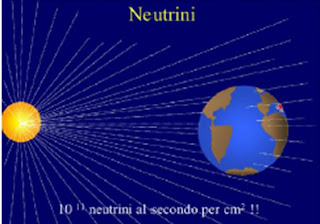

However, if the energy difference is less than 2 m e c 2, then positron emission cannot occur and electron capture is the sole decay mode. As the energy of the decay goes up, so does the branching fraction of positron emission. For low-energy decays, electron capture is energetically favored by 2 m e c 2 = 1.022 MeV, since the final state has an electron removed rather than a positron added. Nuclei which decay by positron emission may also decay by electron capture. Positron emission happens when an up quark changes into a down quark, effectively converting a proton to a neutron. Via the weak interaction, quarks can change flavor from down to up, resulting in electron emission. Neutrons, with no charge, have one up quark and two down quarks ( 2⁄ 3 − 1⁄ 3 − 1⁄ 3 = 0). In a proton, whose charge is +1, there are two up quarks and one down quark ( 2⁄ 3 + 2⁄ 3 − 1⁄ 3 = 1). Quarks arrange themselves in sets of three such that they make protons and neutrons. The two most common types of quarks are up quarks, which have a charge of + 2⁄ 3, and down quarks, with a − 1⁄ 3 charge. Inside protons and neutrons, there are fundamental particles called quarks.
#Neutrino emission plus
As an example, the following equation describes the beta plus decay of carbon-11 to boron-11, emitting a positron and a neutrino: Isotopes which undergo this decay and thereby emit positrons include, but are not limited to: carbon-11, nitrogen-13, oxygen-15, fluorine-18, copper-64, gallium-68, bromine-78, rubidium-82, yttrium-86, zirconium-89, sodium-22, aluminium-26, potassium-40, strontium-83, and iodine-124. The discovery of artificial radioactivity would be cited when the husband-and-wife team won the Nobel Prize. Is a short-lived nuclide which does not exist in nature. The Curies termed the phenomenon "artificial radioactivity", because 30 This was the first example ofĭecay (positron emission).

, and observed that the product isotope 30Įmits a positron identical to those found in cosmic rays by Carl David Anderson in 1932. In 1934 Frédéric and Irène Joliot-Curie bombarded aluminium with alpha particles (emitted by polonium) to effect the nuclear reaction 4 Positron emission is different from proton decay, the hypothetical decay of protons, not necessarily those bound with neutrons, not necessarily through the emission of a positron, and not as part of nuclear physics, but rather of particle physics. Positron emission should not be confused with electron emission or beta minus decay (β − decay), which occurs when a neutron turns into a proton and the nucleus emits an electron and an antineutrino. Positron emission occurs only very rarely naturally on earth, when induced by a cosmic ray or from one in a hundred thousand decays of potassium-40, a rare isotope, 0.012% of that element on earth. Positron decay results in nuclear transmutation, changing an atom of one chemical element into an atom of an element with an atomic number that is less by one unit. The positron is a type of beta particle (β +), the other beta particle being the electron (β −) emitted from the β − decay of a nucleus.Īn example of positron emission (β + decay) is shown with magnesium-23 decaying into sodium-23:īecause positron emission decreases proton number relative to neutron number, positron decay happens typically in large "proton-rich" radionuclides. Positron emission is mediated by the weak force. Positron emission, beta plus decay, or β + decay is a subtype of radioactive decay called beta decay, in which a proton inside a radionuclide nucleus is converted into a neutron while releasing a positron and an electron neutrino ( ν e).


 0 kommentar(er)
0 kommentar(er)
